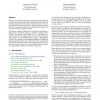506 search results - page 10 / 102 » Where Is the Value in a Program Verifier |
ATVA
2004
Springer
14 years 24 days ago
2004
Springer
Data races do not cover all kinds of concurrency errors. This paper presents a data-
ow-based technique to
nd stale-value errors, which are not found by low-level and high-level d...
POPL
2012
ACM
12 years 3 months ago
2012
ACM
We present a general theory of Gifford-style type and effect annotations, where effect annotations are sets of effects. Generality is achieved by recourse to the theory of algebra...
ICFP
2010
ACM
13 years 8 months ago
2010
ACM
We show how the binary encoding and decoding of typed data and typed programs can be understood, programmed, and verified with the help of question-answer games. The encoding of a...
ENDM
2010
13 years 7 months ago
2010
Verifying that a piece of software has no bugs means proving that it has certain desired properties, such as an array index not taking values outside certain Abstract interpretati...
TCC
2009
Springer
14 years 8 months ago
2009
Springer
Existing definitions of program obfuscation do not rule out malleability attacks, where an adversary that sees an obfuscated program is able to generate another (potentially obfus...

